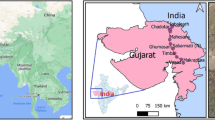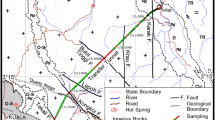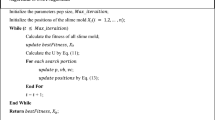Abstract
The undrained shear strength of the sensitive clays is an important parameter for the design of the foundation of the civil engineering structures. In this study, novel hybrid machine learning approaches, namely ANFIS-CA and ANFIS-PSO, are developed to predict the undrained shear strength of the sensitive clays. These approaches are based on adaptive neuro-fuzzy inference system (ANFIS) and two metaheuristic optimizations techniques including cultural algorithm (CA) and particle swarm optimization (PSO). Unlike other empirical methods that relied on accurate determination of the pre-consolidation pressure, the proposed approaches are based on five reliable input parameters: depth, effective vertical stress, natural water content, liquid limit, and plastic limit. For this purpose, data of 216 sensitive clay samples obtained from different parts of Southern Finland were used for validating and training models. Standard statistical measures were used to evaluate performance of the models. The results show that the proposed hybrid ANFIS-PSO model obtained reasonably good accuracy (correlation coefficient: R = 0.715), in comparison with ANFIS-CA model (R = 0.6) in predicting the undrained shear strength of the sensitive clays. Therefore, the ANFIS-PSO model is very promising to predict the undrained shear strength of the sensitive clays with limited input parameters.

















Similar content being viewed by others
Data availability statement
All data, models, or code that support the findings of this study are available from the open source platform GitHub by the following link: https://github.com/QuocAnh90/ANFIS.
References
Prasad KN, Triveni S, Schanz T, Nagaraj LT (2007) Sample disturbance in soft and sensitive clays: analysis and assessment. Mar Georesour Geotechnol 25(3–4):181–197
Di Buò B, Selänpää J, Länsivaara TT, D’Ignazio M (2019) Evaluation of sample quality from different sampling methods in Finnish soft sensitive clays. Can Geotech J 56(8):1154–1168
Tran Q-A, Solowski W, Karstunen M, Korkiala-Tanttu L (2017) Modelling of fall-cone tests with strain-rate effects. Procedia Eng 175:293–301
Tran Q-A, Sołowski W (2019) Generalized Interpolation Material Point Method modelling of large deformation problems including strain-rate effects–application to penetration and progressive failure problems. Comput Geotech 106:249–265
Selänpää J, Di Buò B, Länsivaara T, D’Ignazio M (2017) Problems related to field vane testing in soft soil conditions and improved reliability of measurements using an innovative field vane device. In: Landslides in sensitive clays. Springer, pp 109–119
Hansbo S (1957) New approach to the determination of the shear strength of clay by the fall-cone test.
Chandler RJ (1988) The in-situ measurement of the undrained shear strength of clays using the field vane. In: Vane shear strength testing in soils: field and laboratory studies. ASTM International
Larsson R (1980) Undrained shear strength in stability calculation of embankments and foundations on soft clays. Can Geotech J 17(4):591–602
D’Ignazio M, Phoon K-K, Tan SA, Länsivaara TT (2016) Correlations for undrained shear strength of Finnish soft clays. Can Geotech J 53(10):1628–1645
Mataic I, Wang D, Korkiala-Tanttu L (2016) Effect of destructuration on the compressibility of Perniö clay in incremental loading oedometer tests. Int J Geomech 16(1):04015016
Samui P (2008) Prediction of friction capacity of driven piles in clay using the support vector machine. Can Geotech J 45(2):288–295
Ly H-B, Pham BT (2020) Prediction of shear strength of soil using direct shear test and support vector machine model. Open Constr Build Technol J 14(1):41–50
Kuo Y, Jaksa M, Lyamin A, Kaggwa W (2009) ANN-based model for predicting the bearing capacity of strip footing on multi-layered cohesive soil. Comput Geotech 36(3):503–516
Padmini D, Ilamparuthi K, Sudheer K (2008) Ultimate bearing capacity prediction of shallow foundations on cohesionless soils using neurofuzzy models. Comput Geotech 35(1):33–46
Kanungo D, Sharma S, Pain A (2014) Artificial Neural Network (ANN) and Regression Tree (CART) applications for the indirect estimation of unsaturated soil shear strength parameters. Front Earth Sci 8(3):439–456
Bui DT, Hoang N-D, Nhu V-H (2019) A swarm intelligence-based machine learning approach for predicting soil shear strength for road construction: a case study at Trung Luong National Expressway Project (Vietnam). Eng Comput 35(3):955–965
Zhang W, Wu C, Zhong H, Li Y, Wang L (2020) Prediction of undrained shear strength using extreme gradient boosting and random forest based on Bayesian optimization. Geosci Front 12(1):469–477
Moayedi H, Gör M, Khari M, Foong LK, Bahiraei M, Bui DT (2020) Hybridizing four wise neural-metaheuristic paradigms in predicting soil shear strength. Measurement 156:107576. https://doi.org/10.1016/j.measurement.2020.107576
Jang J-S (1993) ANFIS: adaptive-network-based fuzzy inference system. IEEE Trans Syst Man Cybern 23(3):665–685
Ghorbanzadeh O, Rostamzadeh H, Blaschke T, Gholaminia K, Aryal J (2018) A new GIS-based data mining technique using an adaptive neuro-fuzzy inference system (ANFIS) and k-fold cross-validation approach for land subsidence susceptibility mapping. Nat Hazards 94(2):497–517
Takagi T, Sugeno M (1985) Fuzzy identification of systems and its applications to modeling and control. IEEE Trans Syst Man Cybern 1:116–132
Kennedy J, Eberhart R Particle swarm optimization. In: Proceedings of ICNN'95-International Conference on Neural Networks, 1995. IEEE, pp 1942–1948
Heo JS, Lee KY, Garduno-Ramirez R (2006) Multiobjective control of power plants using particle swarm optimization techniques. IEEE Trans Energy Convers 21(2):552–561
Chen W, Panahi M, Pourghasemi HR (2017) Performance evaluation of GIS-based new ensemble data mining techniques of adaptive neuro-fuzzy inference system (ANFIS) with genetic algorithm (GA), differential evolution (DE), and particle swarm optimization (PSO) for landslide spatial modelling. CATENA 157:310–324
Awad ZK, Aravinthan T, Zhuge Y, Gonzalez F (2012) A review of optimization techniques used in the design of fibre composite structures for civil engineering applications. Mater Des 33:534–544
Qi C, Fourie A, Chen Q (2018) Neural network and particle swarm optimization for predicting the unconfined compressive strength of cemented paste backfill. Constr Build Mater 159:473–478
Qi C, Fourie A, Chen Q, Zhang Q (2018) A strength prediction model using artificial intelligence for recycling waste tailings as cemented paste backfill. J Clean Prod 183:566–578
Reynolds RG, Peng B (2005) Knowledge learning and social swarms in cultural systems. J Math Sociol 29(2):115–132
Sun Y, Zhang L, Gu X (2012) A hybrid co-evolutionary cultural algorithm based on particle swarm optimization for solving global optimization problems. Neurocomputing 98:76–89
Jin X, Reynolds RG Using knowledge-based evolutionary computation to solve nonlinear constraint optimization problems: a cultural algorithm approach. In: Proceedings of the 1999 congress on evolutionary computation-CEC99 (Cat. No. 99TH8406), 1999. IEEE, pp 1672–1678
Reynolds RG, Zhu S (2001) Knowledge-based function optimization using fuzzy cultural algorithms with evolutionary programming. IEEE Transactions on Systems, Man, and Cybernetics, Part B (Cybernetics) 31 (1):1–18
Whitley D (1994) A genetic algorithm tutorial. Stat Comput 4(2):65–85
Dorigo M, Stützle T (2003) The ant colony optimization metaheuristic: Algorithms, applications, and advances. In: Handbook of metaheuristics. Springer, pp 250–285
Ly H-B, Le LM, Duong HT, Nguyen TC, Pham TA, Le T-T, Le VM, Nguyen-Ngoc L, Pham BT (2019) Hybrid artificial intelligence approaches for predicting critical buckling load of structural members under compression considering the influence of initial geometric imperfections. Appl Sci 9(11):2258
Pham BT, Nguyen MD, Van Dao D, Prakash I, Ly H-B, Le T-T, Ho LS, Nguyen KT, Ngo TQ, Hoang V (2019) Development of artificial intelligence models for the prediction of compression coefficient of soil: An application of Monte Carlo sensitivity analysis. Sci Total Environ 679:172–184
Breiman L (2001) Random forests. Mach Learn 45(1):5–32
Boulesteix AL, Janitza S, Kruppa J, König IR (2012) Overview of random forest methodology and practical guidance with emphasis on computational biology and bioinformatics. Wiley Interdiscip Rev: Data Mining Knowl Discov 2(6):493–507
Diaz-Uriarte R, Alvarez de Andrés S (2006) Gene selection and classification of microarray data using random forest. BMC Bioinformatics 7:3. https://doi.org/10.1186/1471-2105-7-3
Okun O, Priisalu H (2007) Random forest for gene expression based cancer classification: Overlooked issues. vol 4478. https://doi.org/10.1007/978-3-540-72849-8_61
Bylander T (2000) Estimating generalization error on two-class datasets using out-of-bag estimates. Mach Learn. https://doi.org/10.1023/A:1013964023376
Wang H, Yang F, Luo Z (2016) An experimental study of the intrinsic stability of random forest variable importance measures. BMC Bioinformatics 17:60–60. https://doi.org/10.1186/s12859-016-0900-5
Kulkarni V, Sinha P (2013) Random forest classifiers: a survey and future research directions. Int J Adv Comput 36:1144–1153
Cao D-S, Liang Y-Z, Xu Q, Zhang L-X, Hu Q-N, Li H-D (2011) Feature importance sampling-based adaptive random forest as a useful tool to screen underlying lead compounds. J Chemom 25:201–207. https://doi.org/10.1002/cem.1375
Lee SSF, Sun L, Kustra R, Bull SB (2008) EM-random forest and new measures of variable importance for multi-locus quantitative trait linkage analysis. Bioinformatics 24(14):1603–1610. https://doi.org/10.1093/bioinformatics/btn239
Ma D, Xiao J, Li Y, Diao Y, Guo Y, Li M (2011) Feature importance analysis in guide strand identification of microRNAs. Comput Biol Chem 35(3):131–136. https://doi.org/10.1016/j.compbiolchem.2011.04.009
Pérez-Rave JI, González-Echavarría F, Correa-Morales JC (2020) Modeling of apartment prices in a Colombian context from a machine learning approach with stable-important attributes. Dyna 87(212):63–72
Le LM, Ly H-B, Pham BT, Le VM, Pham TA, Nguyen D-H, Tran X-T, Le T-T (2019) Hybrid artificial intelligence approaches for predicting buckling damage of steel columns under axial compression. Materials 12(10):1670
Vahidnia MH, Alesheikh AA, Alimohammadi A, Hosseinali F (2010) A GIS-based neuro-fuzzy procedure for integrating knowledge and data in landslide susceptibility mapping. Comput Geosci 36(9):1101–1114. https://doi.org/10.1016/j.cageo.2010.04.004
Khosravi K, Panahi M, Tien Bui D (2018) Spatial prediction of groundwater spring potential mapping based on an adaptive neuro-fuzzy inference system and metaheuristic optimization. Hydrol Earth Syst Sci 22(9):4771–4792
Wan S (2013) Entropy-based particle swarm optimization with clustering analysis on landslide susceptibility mapping. Environ Earth Sci 68(5):1349–1366
Tien Bui D, Khosravi K, Li S, Shahabi H, Panahi M, Singh VP, Chapi K, Shirzadi A, Panahi S, Chen W (2018) New hybrids of anfis with several optimization algorithms for flood susceptibility modeling. Water 10(9):1210
Moayedi H, Tien Bui D, Dounis A, Kok Foong L, Kalantar B (2019) Novel nature-inspired hybrids of neural computing for estimating soil shear strength. Appl Sci 9(21):4643
Kong F, Zhu Q, Sakthivel R, Mohammadzadeh AJN (2021) Fixed-time synchronization analysis for discontinuous fuzzy inertial neural networks with parameter uncertainties. Neurocomputing 422:295–313
Sabzalian MH, Mohammadzadeh A, Lin S, Zhang WJND (2019) Robust fuzzy control for fractional-order systems with estimated fraction-order. Nonlinear Dyn 98(3):2375–2385
Mohammadzadeh A, Hashemzadeh FJASC (2015) A new robust observer-based adaptive type-2 fuzzy control for a class of nonlinear systems. Appl Soft Comput 37:204–216
Acknowledgements
The first author acknowledges the funding from the European Union’s Horizon 2020 research and innovation program under the grant agreement 101022007. The authors also thank Dr. Marco D’Ignazio for sharing this data for carrying out this research.
Author information
Authors and Affiliations
Corresponding author
Ethics declarations
Conflict of interest
The authors declare that they have no known competing financial interests or personal relationships that could have appeared to influence the work reported in this paper.
Additional information
Publisher's Note
Springer Nature remains neutral with regard to jurisdictional claims in published maps and institutional affiliations.
Rights and permissions
About this article
Cite this article
Tran, Q.A., Ho, L.S., Le, H.V. et al. Estimation of the undrained shear strength of sensitive clays using optimized inference intelligence system. Neural Comput & Applic 34, 7835–7849 (2022). https://doi.org/10.1007/s00521-022-06891-5
Received:
Accepted:
Published:
Issue Date:
DOI: https://doi.org/10.1007/s00521-022-06891-5




